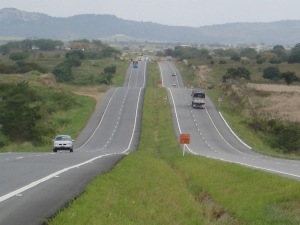Missing Building Blocks
 Latin America’s disappointing 2.5% economic growth last year was coupled a fall in infrastructure investment, a key factor to the region’s economic well-being. Infrastructure megaprojects have been sporadic in Latin American history. Perhaps the most iconic megaproject in the region is the early-1900s US-sponsored Panama Canal, a project crucial for the economy of the isthmus, until today. Brazil’s early-1970s Trans-Amazonian highway was one of the largest projects carried out in South America, which although very positive for Brazil’s economic development, inevitably caused one of the greatest deforestations of the Amazon rainforest. As much as these megaprojects have had great legacies, however, they are notably scarce in the region, and infrastructure investment in general has fallen behind at 2% GDP, half of what is needed to sustain economic growth.
Latin America’s disappointing 2.5% economic growth last year was coupled a fall in infrastructure investment, a key factor to the region’s economic well-being. Infrastructure megaprojects have been sporadic in Latin American history. Perhaps the most iconic megaproject in the region is the early-1900s US-sponsored Panama Canal, a project crucial for the economy of the isthmus, until today. Brazil’s early-1970s Trans-Amazonian highway was one of the largest projects carried out in South America, which although very positive for Brazil’s economic development, inevitably caused one of the greatest deforestations of the Amazon rainforest. As much as these megaprojects have had great legacies, however, they are notably scarce in the region, and infrastructure investment in general has fallen behind at 2% GDP, half of what is needed to sustain economic growth.
Brazil, widely considered the region’s powerhouse, provides an example of how far behind the region lags in infrastructure quality. Despite its recent successes in decreasing income inequality and its rank as the 7th largest economy in the world, Brazil is ranked only 24th in infrastructure. Last year’s September, Brazil saw failures in auctioning government concessions of roads, including the BR-262 highway—part of President Rousseff’s infrastructure agenda. Latin America’s widespread but usual strategy in infrastructure investment, public-private partnerships (PPPs), has also seen significant delays and failures, they often lead to claims of fraud and cronyism.
Currently, there are some projects being carried out in Latin America, albeit with severe critiques from both the environmental and legislative sides. The Belo Monte Dam in Brazil, designed to go through the Xingu River creating 2 reservoirs, was first proposed during Brazil’s military dictatorship in 1975. It has recently obtained a license in 2011 to begin preliminary construction, although opposition to the project remains.
In Central America, the talk of an inter-oceanic canal through Nicaragua has sparked after a Chinese enterprise, HKND, proposed the megaproject to the Nicaraguan government last year. The so-called “route 4” would run one-way from east to west, from the port on the Caribbean in Punta Gorda, to Port Brito on the Pacific, and would include many sub-projects around the canal, including a touristic complex, an airport and multiple roads. Despite the great influx of investment and creation of jobs that the inter-oceanic canal would create for Nicaragua, its private sector is only more and more preoccupied of its environmental consequences, and skeptical of the reliability of HKND. Within less than a month before construction is expected to start, Nicaraguans can hardly ignore the lack of transparency in the studies presented to the public about the canal and the amount of jobs it could generate.
Major critics of the megaproject include Jaime Incer Barquero, distinguished environmental scientist, and Victor Campos, director of the Humboldt Center for environmental issues1. He states that the expected 500-meter width of the canal would cut right though the Mesoamerican Biological Corridor and would endanger legally protected environmental zones, destroying nearly 1 million acres of tropical rainforest and wetland. Perhaps the greatest environmental danger the canal presents is in Lake Nicaragua, which holds the largest deposit of fresh water in Central America for human and agricultural uses. With nearly half-million cubic meters of fresh water drained into the ocean with each ship, a perfectly good source for drinking water would be wasted.
Nonetheless, the overall scarcity and inefficiency of infrastructure projects seem to be consequences of late-XX century state intervention and current attempts at improving institutional transparency. Infrastructure investment, especially the sort that goes hand-in-hand with the private sector, has suffered since the 1980s debt crisis and in the face of the remnants of statist development. A major weakness in infrastructure investment is also the overall lack of instructed engineers in the public sector who oversee either public projects or PPPs, and the lack of transportation authority entities in major cities. However, a push towards improving the efficiency in infrastructure through economic integration occurred in the early 2000s, when the IIRSA (Initiative for the Integration of the Regional Infrastructure in South America) came into place, supported by entities such as the Inter-American Development Bank.
The reality is that without proper investment in infrastructure, Latin America will not be able to grow at a sustainable rate, or support the economic growth that has already taken place in the region. Investments in infrastructure would increase Latin America’s wages, as better infrastructure bridges obstacles to international trade, and domestic productivity would go increase. Jorge Familiar, World Bank regional director, has pointed out that SMEs (small and medium enterprises) that began 4 years ago in Latin America are now half the size of those that started 4 years ago elsewhere2. According to a World Bank survey, Latin America’s annual economic growth rate could rise by 5 percentage points if its infrastructure matched that of East Asia. As Latin America sees for the first time in its history a middle class larger than the percentage of people living in poverty, many experts warn of future traffic-jammed streets and the battered roads: signs that lagging infrastructure investment. This is the fundamental cause for the region’s restrained growth, and it is only through comprehensive infrastructure projects—coupled with improved education programs—that the countries in the region can become stable, developed economies.
